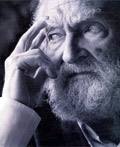
The Avars
Oteiza is the name of a work of art
- The exhibition: Impressed Leather Place: The Boulevard Room (San Sebastián) As I walked from Rosi’s kiosk to Parte Vieja through a window of the room I saw Oteiza, a few steps ahead of the “Free entrance”, and I couldn’t miss it. One hundred years, twenty-five others: Father and son Larrquert are exhibiting under the pretext that the Lamia studio has completed a quarter of a century. The work, divided into three parts, will be on display until May 18. Not enough time but, and I saw the only part of the exhibition that includes photographs of Jorge Oteiza. Some are loose portraits, others to be read as a series; color and black and white in confusion, along with otestar thoughts that can be read on the walls.

Oteiza
The sculptor-thinker-poet of Orio can be seen in different periods of life. Two highlights: the artist in front of the Bilbao City Hall, inaugurating the ovoid variant of the Sphere’s unoccupation, last standing; and the photographic section taken after the death of Itziar, which shows that Oteiza was being torn apart.
The Larrkers have turned the artist into a work of art, with all the dangers that this entails. Because it is possible to dazzle with the ice eyes of the man of the portraits, with the aesthetics of the artist himself, forgetting the work he did.
Apart from these issues – I’m not going to start to stress the importance of Oteiza’s work, which has been talked about a lot in this centenary – I’ve always found it difficult to see the artist and the person separated in this case, perhaps because the line between the two was more blurred than in many others. It seems to me that the exhibition has managed to draw this line thanks to the photographs that are shown with the nephews and the family and the section of the Itziar mentioned. A
flash at last: enter the room and you will find the space divided into three parts. If they haven’t changed it, you’ll see some arrows starting from the left wall as indicating the direction in which the photos should be viewed. If those arrows had penetrated my thigh, they wouldn't have bothered me more than they did on the wall. The viewer should be allowed to decide where to start and where he wants to finish the exhibition.
The Larrkers have turned the artist into a work of art, with all the dangers that this entails. Because it is possible to dazzle with the ice eyes of the man of the portraits, with the aesthetics of the artist himself, forgetting the work he did.
Apart from these issues – I’m not going to start to stress the importance of Oteiza’s work, which has been talked about a lot in this centenary – I’ve always found it difficult to see the artist and the person separated in this case, perhaps because the line between the two was more blurred than in many others. It seems to me that the exhibition has managed to draw this line thanks to the photographs that are shown with the nephews and the family and the section of the Itziar mentioned. A
flash at last: enter the room and you will find the space divided into three parts. If they haven’t changed it, you’ll see some arrows starting from the left wall as indicating the direction in which the photos should be viewed. If those arrows had penetrated my thigh, they wouldn't have bothered me more than they did on the wall. The viewer should be allowed to decide where to start and where he wants to finish the exhibition.